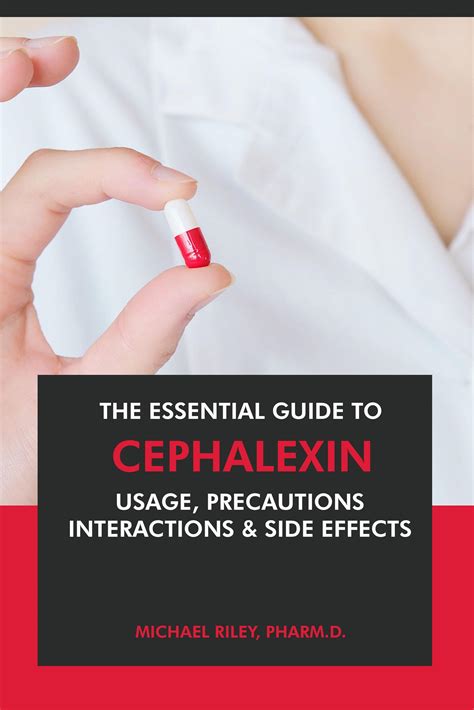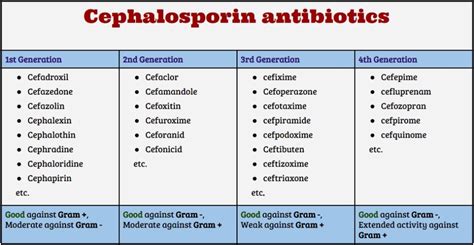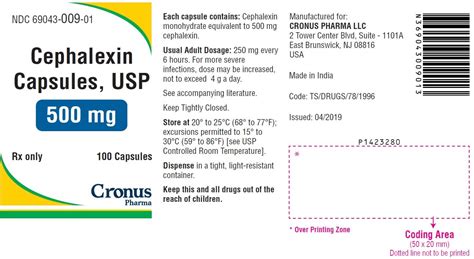Intro
Discover Cephalexin antibiotic uses, dosage, and side effects. Learn about its bacterial infection treatments, including skin and urinary tract infections, and understand its role in combating antibiotic-resistant strains.
Cephalexin is a broad-spectrum antibiotic that belongs to the class of cephalosporins. It is widely used to treat various bacterial infections, and its effectiveness has made it a popular choice among healthcare professionals. The importance of cephalexin lies in its ability to combat bacterial infections that can cause significant harm if left untreated. In this article, we will delve into the world of cephalexin, exploring its uses, benefits, and working mechanisms.
Cephalexin is a crucial medication in the fight against bacterial infections. Its broad-spectrum activity allows it to target a wide range of bacteria, making it an effective treatment option for various conditions. From skin infections to respiratory tract infections, cephalexin has proven to be a reliable choice. Moreover, its relatively low cost and availability have made it accessible to people worldwide. As we explore the uses of cephalexin, it becomes clear that this antibiotic plays a vital role in maintaining public health.
The use of cephalexin has been extensive, and its applications continue to grow. With the rise of antibiotic-resistant bacteria, the development of effective antibiotics like cephalexin is crucial. By understanding how cephalexin works and its various uses, we can appreciate the importance of this medication in modern medicine. Whether it's treating a simple skin infection or a more complex respiratory condition, cephalexin has proven to be a valuable tool in the fight against bacterial infections.
Cephalexin Antibiotic Overview

Cephalexin is a first-generation cephalosporin antibiotic that works by inhibiting the growth of bacteria. It does this by binding to the bacterial cell wall, preventing the formation of a stable cell wall, and ultimately leading to the death of the bacterial cell. This mechanism of action makes cephalexin effective against a wide range of Gram-positive and some Gram-negative bacteria.
Types of Bacterial Infections Treated with Cephalexin
Cephalexin is used to treat various bacterial infections, including: * Skin and soft tissue infections, such as impetigo, folliculitis, and cellulitis * Respiratory tract infections, such as pneumonia, bronchitis, and sinusitis * Urinary tract infections, such as cystitis and pyelonephritis * Bone and joint infections, such as osteomyelitis and septic arthritisCephalexin Uses and Benefits

The benefits of cephalexin are numerous, making it a popular choice among healthcare professionals. Some of the key benefits include:
- Broad-spectrum activity, allowing it to target a wide range of bacteria
- Effective against both Gram-positive and some Gram-negative bacteria
- Relatively low cost and availability, making it accessible to people worldwide
- Can be administered orally, making it a convenient treatment option
Cephalexin Working Mechanism
Cephalexin works by inhibiting the growth of bacteria through the following mechanism: 1. Binding to the bacterial cell wall, preventing the formation of a stable cell wall 2. Inhibiting the synthesis of the bacterial cell wall, leading to the death of the bacterial cell 3. Interfering with the bacterial cell membrane, causing the cell to become permeable and leading to the death of the bacterial cellCephalexin Side Effects and Precautions

While cephalexin is generally well-tolerated, it can cause some side effects, including:
- Gastrointestinal upset, such as diarrhea, nausea, and vomiting
- Allergic reactions, such as rash, itching, and hives
- Increased risk of Clostridioides difficile (C. diff) infection
- Interactions with other medications, such as blood thinners and diabetes medications
Cephalexin Precautions and Contraindications
Cephalexin is contraindicated in patients with: * Known allergy to cephalexin or other cephalosporins * History of severe allergic reactions to penicillins * Pregnancy or breastfeeding, unless the benefits outweigh the risksCephalexin Dosage and Administration

The dosage and administration of cephalexin vary depending on the condition being treated and the patient's age and weight. Typical dosages include:
- Adults: 250-500 mg every 6 hours for 7-14 days
- Children: 25-50 mg/kg/day divided into 2-4 doses for 7-14 days
Cephalexin Interactions and Contraindications
Cephalexin can interact with other medications, including: * Blood thinners, such as warfarin * Diabetes medications, such as metformin * Probenecid, which can increase the levels of cephalexin in the bloodCephalexin Resistance and Misuse

The misuse and overuse of cephalexin have contributed to the development of antibiotic-resistant bacteria. To prevent this, it is essential to:
- Use cephalexin only when necessary and as prescribed by a healthcare professional
- Complete the full course of treatment, even if symptoms improve before finishing the medication
- Avoid sharing or saving antibiotics for future use
Cephalexin and Antibiotic Stewardship
Antibiotic stewardship programs aim to promote the responsible use of antibiotics, including cephalexin. These programs: * Monitor antibiotic use and resistance patterns * Develop guidelines for antibiotic use * Educate healthcare professionals and patients about the responsible use of antibioticsCephalexin in Veterinary Medicine

Cephalexin is also used in veterinary medicine to treat bacterial infections in animals. Its use in animals is similar to its use in humans, with the dosage and administration varying depending on the condition being treated and the animal's weight and age.
Cephalexin in Veterinary Medicine: Benefits and Risks
The benefits of cephalexin in veterinary medicine include: * Effective treatment of bacterial infections in animals * Relatively low cost and availability * Can be administered orally, making it a convenient treatment option However, the risks of cephalexin in veterinary medicine include: * Development of antibiotic-resistant bacteria * Side effects, such as gastrointestinal upset and allergic reactions * Interactions with other medicationsCephalexin: Future Perspectives and Research

Research is ongoing to develop new antibiotics, including new cephalosporins, to combat the growing problem of antibiotic resistance. The future of cephalexin and other antibiotics depends on responsible use and the development of new treatment options.
Cephalexin: Conclusion and Recommendations
In conclusion, cephalexin is a valuable antibiotic that has been used to treat various bacterial infections. Its benefits, including broad-spectrum activity and relatively low cost, make it a popular choice among healthcare professionals. However, the risks of antibiotic resistance and side effects must be considered, and responsible use is essential to ensure the continued effectiveness of cephalexin and other antibiotics.We invite you to share your thoughts and experiences with cephalexin in the comments below. Have you or a loved one used cephalexin to treat a bacterial infection? What were your experiences with the medication? By sharing your stories and engaging in the conversation, we can work together to promote the responsible use of antibiotics and ensure the continued effectiveness of these life-saving medications.
What is cephalexin used for?
+Cephalexin is used to treat various bacterial infections, including skin and soft tissue infections, respiratory tract infections, urinary tract infections, and bone and joint infections.
How does cephalexin work?
+Cephalexin works by inhibiting the growth of bacteria through the inhibition of cell wall synthesis, ultimately leading to the death of the bacterial cell.
What are the common side effects of cephalexin?
+Common side effects of cephalexin include gastrointestinal upset, such as diarrhea, nausea, and vomiting, as well as allergic reactions, such as rash, itching, and hives.
Can cephalexin be used in veterinary medicine?
+Yes, cephalexin can be used in veterinary medicine to treat bacterial infections in animals, with the dosage and administration varying depending on the condition being treated and the animal's weight and age.
What is the future of cephalexin and other antibiotics?
+The future of cephalexin and other antibiotics depends on responsible use and the development of new treatment options to combat the growing problem of antibiotic resistance.
